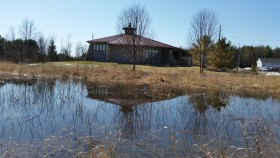In nature, the iconic woodcutting animal is the beaver. Beavers have twenty teeth, but the four front incisors are the most important for wood cutting. These curved teeth are strong enough to gnaw down trees. But the strength involves more than than just the teeth. Beavers have massive skulls and also powerful jaw muscles.
Most people are shocked to know that beaver teeth are orange. This color is caused by minerals in the enamel. The orange enamel makes up front, but the back side of each tooth is a softer material called dentin.
As a beaver bites off chunks of a tree trunk, the soft dentin from the back of each tooth is worn away while the enamel in front becomes as sharp as a well maintained garden tool.
Most beavers go into winter well prepared. Besides building their lodges, the beavers store a generous supply of branches under water. The tree of choice is aspen. Beavers love aspen. They’ll eat the inner bark of other trees—willow…..birch…..if they have to, but aspen is their absolute favorite–which is handy. Aspen often grows near water.
The beavers clip the twigs from the saplings and branches. Then holding the wood in their teeth, they drag each to the bottom of their pond, jamming the sticks into the mud near one of the underwater entrances of the lodge. By the time the pond freezes over, the underwater cache usually has more than enough bark to see the whole beaver family through the winter.
Of course, to have a pond around their lodges, beavers must first build a dam across a stream. Once that dam is in place (and constantly maintained) water behind the dam becomes
deep enough to protect a lodge entrance. But water also spreads out, changing the shoreline and creating wetlands. Of course, beavers don’t need to worry zoning regulations,
Humans do. And because of state mandated regulation changes, a new Shoreline Zoning Ordinance was adopted by Door County in September of 2016. On Monday, March 6 from 3:00 to 5:00, the Door County Planning Department will offer an Informational Meeting Regarding Shoreland Zoning. They will discuss regulatory provisions for wetlands, shoreline standards,permits and mitigation. Members of the Resource Planning Committee and the Door County Board of Adjustent will be on hand. This educational meeting is open to the public.
Our Ski For Free Program will be resurrected if and when we have adequate snow. Visit www.CrossroadsatBigCreek. org for current conditions and Ski For Free status.
Crossroads at Big Creek is a donor support facility made up of the Big Creek, The Cove, and the Ida Bay preserves. The Collins Learning Center, located at 2041 Michigan just east of the Highway 42/57 Roundabout in Sturgeon Bay, is open 2:00-4:00 daily and during scheduled activities. Trails in all preserves are open 24/7 free of charge.
Sunday, March 5
12:30 Aldo Leopold Weekend
Crossroads will host the third session of the marathon read of A DoorCounty Almanac. Guest readers will share essays from this inspiring book. Refreshments will be offered.
Monday March 6
3:00 Door County Planning Department Informational Meeting Regarding New County Shoreland Zoning Regulation
Learn about the new state-mandated regulations for wetlands and shorelands. Topics such as lot size, Imperious surfaces, height limitations, ordinary high water mark setbacks, and nonconforming structure allowances. Free and open to the public.
Tuesday, March 7
7:00 Master Gardener Lecture: “Tools, Tricks, Tried and True”
Jason Feldman of Jason Feldman Landscapes will discuss the tools and tricks which make gardening easier and more effective. This program is free and open to the public.


